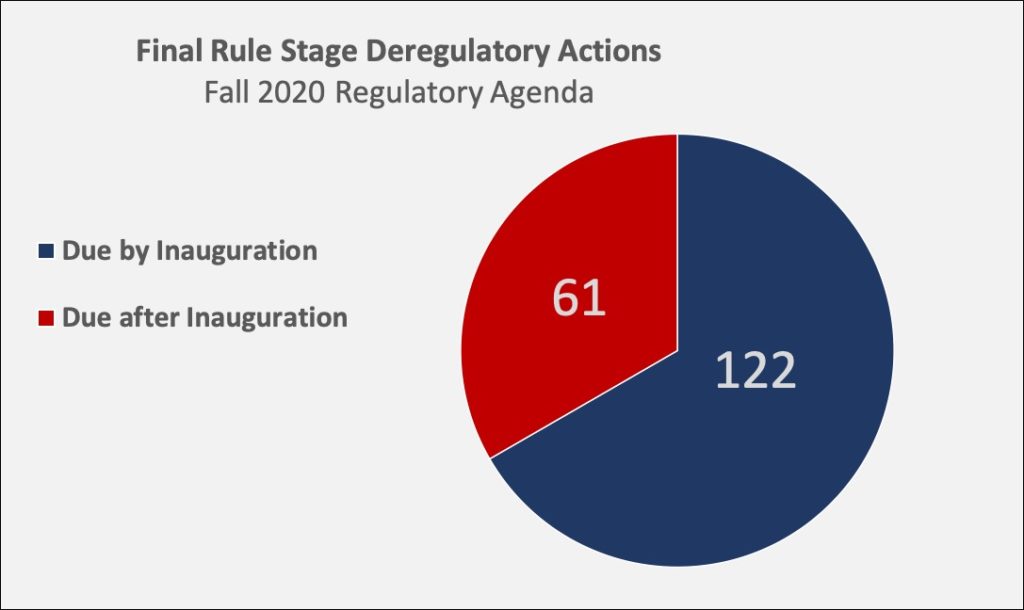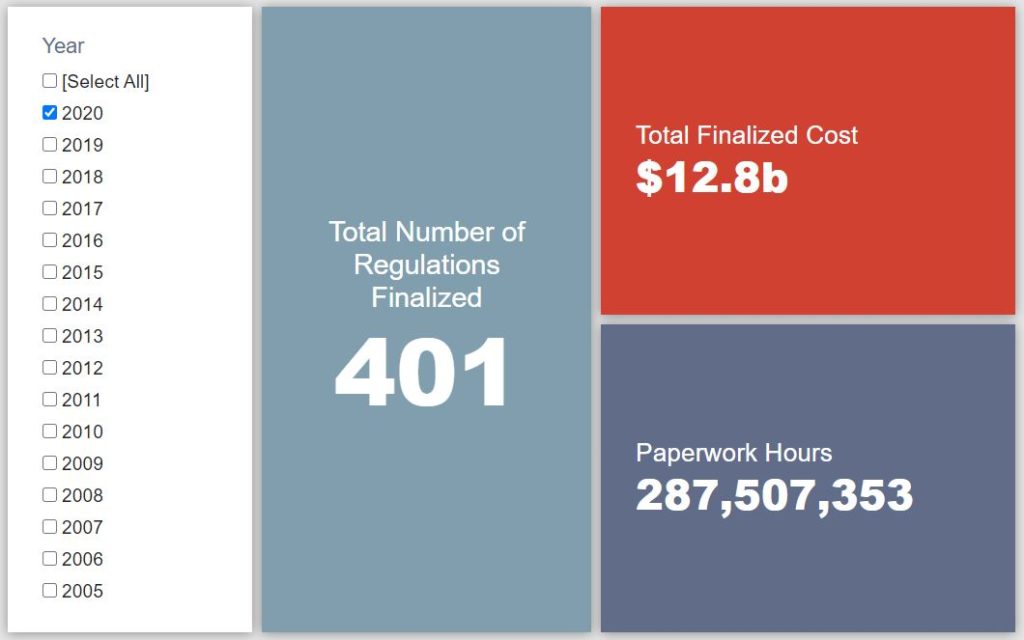Week in Regulation
December 14, 2020
Cost Cuts Keep Rolling
Building upon the prior week’s momentum, this past week saw another fairly active period of rulemaking that landed in the net-savings column. Actions from the Departments of Interior (DOI) and Transportation (DOT) were the main highlights. Across all rulemakings, agencies published $2.1 billion in total net cost savings but added 775,007 hours of annual paperwork. Additionally, the Trump Administration released its final regulatory agenda.
REGULATORY TOPLINES
- Proposed Rules: 34
- Final Rules: 67
- 2020 Total Pages: 80,482
- 2020 Final Rule Costs: $12.8 billion
- 2020 Proposed Rule Costs: $18.6 billion
TRACKING THE REGULATORY BUDGET
The most significant deregulatory action of the week was DOI’s proposed rule regarding “Revisions to the Requirements for Exploratory Drilling on the Arctic Outer Continental Shelf.” The proposal seeks to amend various aspects of a 2016 rule on the same topic in order to allow for more expansive drilling operations. According to DOI’s estimates, these revisions could save affected entities $142.2 million per year (or $1.5 billion in present value). Since it is still a proposed rule, however, these savings would not apply to the fiscal year (FY) 2021 regulatory budget. Furthermore, considering how late the measure comes in the Trump term, it a virtual certainty that it will be one of many proposed actions the incoming Biden Administration puts on ice.
The most significant final rule that will officially hit the books, and thus the FY 2021 regulatory budget, is DOT’s rule on “Miscellaneous Amendments to Brake System Safety Standards and Codification of Waivers.” The rule primarily takes a series of previously granted waivers on freight rail braking requirements and codifies them as a matter of practice going forward. DOT estimates that this could yield just over $500 million in net present value savings over a 10-year window.
While the administration’s FY 2021 regulatory budget caps are still forthcoming, so far into FY 2021 agencies have officially published 49 deregulatory actions and 14 regulatory actions (as defined by Executive Order (EO) 13,771), totaling $34.5 billion in quantified total net costs. It is worth noting at this point, however, that regardless of whether or not the current administration releases said caps, the Biden Administration assumes power in January 2021. It is highly unlikely that EO 13,771 will remain operative (at least in anything resembling its current form) beyond then, and thus the FY 2021 regulatory budget “window” will be a truncated one. Nevertheless, the American Action Forum (AAF) will continue to track EO 13,771 activity through the end of the administration to provide a record of the regulatory budget initiative’s historical legacy and implications. AAF’s review of the administration’s FY 2020 regulatory budget progress can be found here.
THIS WEEK’S REGULATORY PICTURE
This week, a lame duck regulatory agenda.

On December 9, the Office of Information and Regulatory Affairs (OIRA), the office within the White House that reviews regulations, released its Fall 2020 Unified Agenda of Regulatory and Deregulatory Actions – more commonly referred to as the regulatory agenda. The agenda is published twice yearly and provides updates on rules agencies are working on over the next year.
This agenda takes on a different meaning with the Trump Administration winding down in a little over a month. Rather than show what rules one can expect over the next year it provides some insight on actions likely to be midnight rules, or rules issued in the waning days of an administration.
The data show the Trump Administration will be busy right up until the end of its term, particularly on deregulatory actions. Of the 183 deregulatory actions currently in the final rule stage expected to be issued over the next 12 months, 122 – or two-thirds – are due to come out by the end of January, or, more likely, by inauguration. Those not published in the Federal Register prior to the start of the Biden Administration will likely be put on hold, and most will be withdrawn.
The Trump Administration typically releases the results of the previous fiscal year’s regulatory budget concurrently with the regulatory agenda. This year no results have been released. The introduction to the regulatory agenda, however, mentions that over the course of the administration $198.6 billion in regulatory costs have been eliminated. Subtracting out the administration’s estimate of $50.9 billion in savings through the end of FY 2019, that sum means that approximately $147.7 billion in savings is from FY 2020. That total is less than AAF’s projected FY 2020 savings of $171.7 billion.
TOTAL BURDENS
Since January 1, the federal government has published $31.3 billion in total net costs (with $12.8 billion from finalized rules) and 346.3 million hours of net annual paperwork burden increases (with 287.5 million hours due to final rules). Click here for the latest Reg Rodeo findings.












